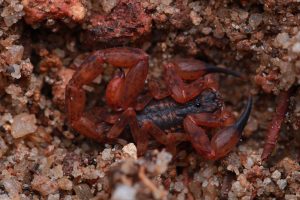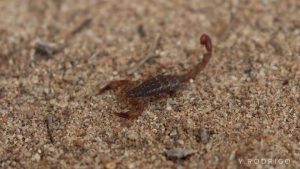Scorpions belong to Kingdom Animalia, Phylum Arthropoda, Class Arachnida, and Order Scorpiones. There are about 2000 species of scorpions all over the world except polar regions. They are classified under 6 superfamilies and 13 families. Around 30 – 40 species are venomous and have the ability to kill a human. Scorpions are mainly carnivorous animals and usually feed on insects. Thus, they are pest controllers and beneficial. Their body is divided into 3 main parts call cephalothorax, pre-abdomen, post-abdomen like other arthropods. The 4 pairs of walking legs are attached to the pre-abdomen and they help to protect from predators and catch prey. The pedipalps pair is attached to the cephalothorax and it uses to catch prey and protect themselves. The post-abdomen is made-up of metasomal segments. At the end of the post-abdomen (tail), there is the sharp and pointed sting and it is used to sting for catching prey and protection. All the scorpions are venomous but there are different levels of venomous according to the LD50 value. Annually 1.2 million scorpion stings and about 3250 are recorded. At present Egypt has the most deaths by scorpion stings per year. Scorpions have distributed only over 5 continents ( South America, North America, Europe, Asia, and Australia). Commonly they live in rain-forests, deserts and disturbed human habitats from sea level to around 5000m. Usually, they have been found on shady places such as under rocks, fallen logs, and among dead epidermal shales on trees. Sometimes even in man-made habitats such as houses.
Sri Lanka is home for 20 different species of scorpions that belong to 9 genera and 4 families. They are distributed throughout all-over Sri Lanka including the wet zone, dry zone, and the intermediate zone. Genus Buthoscorpio, Genus Hottentotta, Genus Lychas, Genus Chaerilus, and Genus Liocheles have only one species per each genus. Genus Reddyanus has the most number of species(6). The only deadly venomous scorpion species is Hottentotta tamulus (Indian red scorpion). There are no studies about the venomous level of other scorpions found in Sri Lanka.
Most people think these creatures are harmful. but the truth is they only used their venom when it got a threat or for self-defense .but scorpions got so many threats from humans such as killing them, destroying their habitats, and smuggling them. The illegal trade of live animals has become a major issue for scorpions.in 14 January 2020 A Chinese man has been caught trying to smuggle around 200 scorpions out of Sri Lanka. This is an incident that happened recently but before this incident, there were similar cases around Sri Lanka.
There are been only a few scientific studies about this wonderful animal in Sri Lanka. we hope there will be more studies in future and research programs to discover the hidden life of scorpions.
Genus Buthoscorpio
- Buthoscorpio sarasinorum
Genus Charmus
- Charmus laneaus
- Charmus saradieli
Genus Hottentotta
- Hottentotta tamulus
Genus Isometrus
- Isometrus maculatus
- Isometrus thwaitesi
Genus Lychas
- Lychas srilankensis
Genus Reddyanus
- Reddyanus basilicus
- Reddyanus basucheti
- Reddyanus ceylonensis
- Reddyanus jayarathnei
- Reddyanus loebli
- Reddyanus ranawanai


Genus Chaerilus
- Chaerilus ceylonensis
Genus Liocheles
- Liocheles australasiae

Liocheles australasiae
Genus Heterometrus
- Heterometrus gravimanus
- Heterometrus indus
- Heterometrus serratus
- Heterometrus swammerdami
- Heterometrus yaleensis

Heterometrus indus | Chamod Gunathilake©
Check this out : Introduction to Common Spiders of Sri Lanka


